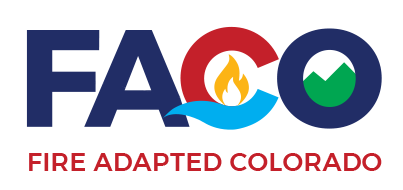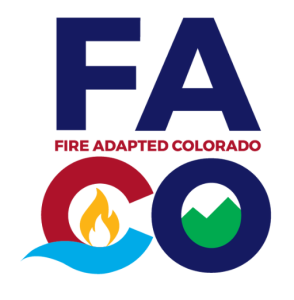A STATEWIDE COHESIVE STRATEGY CONVENING
THE CONCEPT
To my knowledge, before last week there had never been an open invitation wildfire strategy gathering bringing together professionals from wildfire preparedness, landscape-scale collaboratives, fire response and prescribed fire, industry, and science in Colorado. The first of its kind CO-EXIST WITH WILDFIRES cohesive strategy convening held in Denver on April 1st was no joke. This event, which bridged science with the tenets of the national cohesive strategy and included industry folks, captured broad perspectives and employed cutting-edge facilitation strategies to make the most of a half-day gathering. Seventy three professionals adjourned hungry for more.
Given the great value of in-person connections for sharing what wildfire mitigation professionals are doing, what is and isn’t working, and developing better solutions together, Fire Adapted Colorado (FACO) tries to get members together once or twice a year. With a national post-fire conference, After the Flames, planned in our beautiful state that we wanted to encourage FACO members to attend, we thought why host an entirely separate meeting this spring. I quickly realized another Colorado group, the Watershed Wildfire Protection Group, had the same thought. I reached out to the conference organizers at Coalitions and Collaboratives to see how we could fit into their schedule, and I found out that they had the Embassy Suites Conference Center reserved for Monday morning, but their conference didn’t kick-off until midday. They readily agreed to allow FACO to use the space.
In starting the planning I had two of the three cohesive strategy tenets covered — resilient landscapes and fire adapted communities — but wanted some representation from fire. I reached out to Kirk Will, the FACO board liaison with the Division of Fire Prevention and Control (DFPC), who is also a member of the CO Prescribed Fire Council Steering Board. He was enthusiastic about an opportunity to reach a statewide group of professionals. I also wanted a direct connection to the cohesive strategy so I contacted Katie Lighthall, coordinator for the West Regional Strategy Committee, who quickly supported the idea of a statewide convening. I finally had vocal support from statewide groups representing the three goal areas of the Cohesive Wildland Fire Management Strategy, free conference space, and three months to pull something together during the midst of a federal government shutdown.
ORGANIZING A STATEWIDE EVENT IN UNDER THREE MONTHS
Vocalized support is one thing. Pulling off a productive half-day wildfire strategy session is something else entirely. But I was up for the challenge!!
I knew we would need many voices and groups to promote the event during the narrow planning window, and I quickly wrote a request for planning assistance to my contacts, most of whom I’ve had limited interactions with or only knew by name, to over 20 groups and agencies engaged in implementing the Cohesive Strategy across Colorado, excluding any federal partners, who were all on furlough. Representatives from the Colorado Resiliency Office, Watershed Wildfire Protection Group, Colorado State Forest Service (CSFS), Colorado Department of Natural Resources, Colorado Prescribed Fire Council, Colorado Timber Industry Association (CTIA), Colorado Association of Realtors, and the West Regional Strategy Committee joined a planning call with just over two months to plan. They agreed unanimously to move forward with a half-day meeting with the objectives that participants would:
- Understand individual, organization, and agency roles in helping Coloradans live with wildfires;
- Work with fellow professionals to identify barriers to implementing wildfire resilience strategies and establish first steps to overcome those barriers;
- Work across disciplines to find opportunities to support each other’s effort with existing capacity; and
- Identify next steps for collective conversation and action.
Another planning meeting was scheduled with commitments to work on the agenda, logistics, funding, and publicity.
I also needed buy-in from the Fire Adapted Colorado board to work on this. As a part-time contracted Director, project capacity is limited for a young organization striving to engage our existing members. Thankfully, my amazing board said that if I could fund the time and expenses, go for it. For my planned engagement supporting After the Flames, Coalitions and Collaboratives agreed to support my travel. The Watershed Research & Training Center agreed to let me shift around some existing award funds, given that we had completed two of our agreement activities with significant cost savings, and when the Colorado Association of Realtors representative was unable to secure support due to the short turnaround, the West Regional Strategy Committee was able to step up to sponsor some meeting supplies. Whew! All expenses covered!
Now the work of finalizing an agenda, outreach and logistics became a reality. Input on the agenda ranged widely, from presentations to text-to-polling options, and a good draft agenda, flyer, and registration page were ready by the next planning call. There was back and forth about having presenters from various watershed-scale groups that are broadly managing for wildfires in their landscapes or to feature specific agencies to expand on participants’ knowledge of available resources. In anticipation of participants with oodles of collective experience gathered in one place for a very short time, the challenge became to design an agenda that would capture the breadth of expertise rather than highlighting the work of a small portion of the participants. We decided to try to capture the gist of what is happening in the state by topic, originally starting with Science, Fire Adapted Communities, Resilient Landscapes, Safe & Effective Response, Prescribed Fire, and Post-Fire. We eventually whittled this down to five topics, making the agenda feel much more realistic and giving the direction that each topic overview presentation should consider the full cycle of fire; before, during, and after wildfires. Planned and unplanned fire were to be considered collectively, since many fire response practitioners also engage in planned fire ignition.
This left us only five weeks left to secure presenters, facilitators, and registrars, and spread the word to gain broad participation. Selecting and securing presenters who could provide broad overviews of each topic area (in 5 minutes or less) proved to be a critical element. We quickly realized that one person, alone, shouldn’t be tasked with speaking on behalf of an entire state of practitioners, and so teams of people were identified to meet the challenge. Someone would still need to present the overviews, and so spokespeople were selected who represented state agencies, federal government, networks, and the business community, resulting in diverse representation. Direction was crafted on what was desired of the topic flash presentations and direct outreach was made to potential leaders for each topic, including planning team members who stepped forward to take the lead for Fire Adapted Communities and Industry. Planning team members also stepped up to facilitate topic groups for the exercises and to sign people in upon arrival. Colorado State Forest Service had further questions about their role, and took initiative to be more engaged in developing and contributing to the overview presentations and securing the State Forester to provide welcoming remarks. Questions also arose about where the federal partners were, and in the final month we were able to bring in Region 2 of the USDA Forest Service to provide input, join a couple of planning calls, and ensure USDA Forest Service participation during the convening.
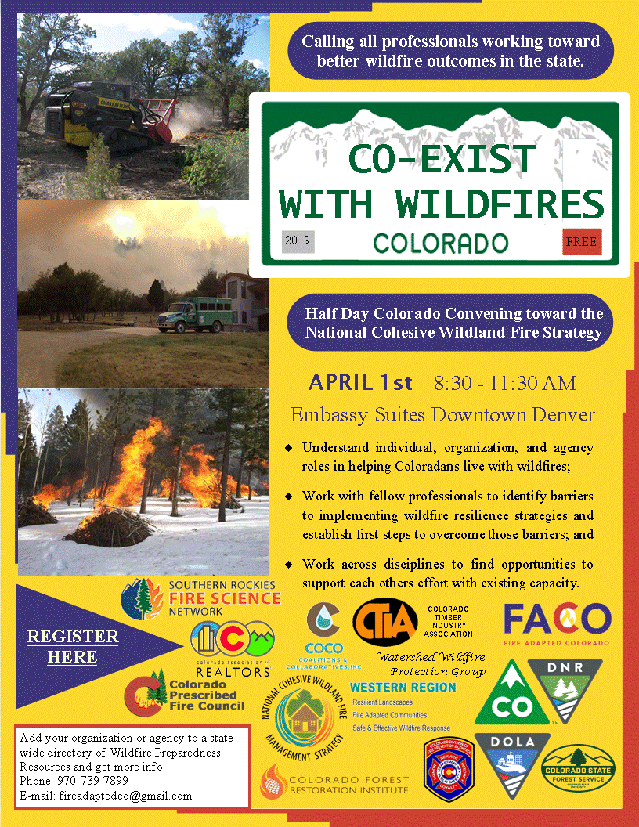
Finding a lead for “Fire on the Landscape” proved to be one of the largest challenges, as our planning team didn’t have much breadth in the fire management realm. At three weeks out, I didn’t have a lead to pull together or present an overview for the topic or anyone willing to facilitate that group. After some bulk emails trying to find a lead, Brian Keating, the Region 2 USDA Forest Service fuels and fire ecology lead, agreed to participate and act as a spokesperson. To support the gathering of diverse input into the Planned and Unplanned Fire on the Landscape presentation, I developed a very short questionnaire that email recipients could fill out electronically to share what innovative or successful practices they were employing in Colorado. This garnered seven sets of great responses. The above promotional flyer demonstrates most of the agencies and groups that had some hand in supporting CO-EXIST WITH WILDFIRES.Finding a lead for “Fire on the Landscape” proved to be one of the largest challenges, as our planning team didn’t have much breadth in the fire management realm. At three weeks out, I didn’t have a lead to pull together or present an overview for the topic or anyone willing to facilitate that group. After some bulk emails trying to find a lead, Brian Keating, the Region 2 USDA Forest Service fuels and fire ecology lead, agreed to participate and act as a spokesperson. To support the gathering of diverse input into the Planned and Unplanned Fire on the Landscape presentation, I developed a very short questionnaire that email recipients could fill out electronically to share what innovative or successful practices they were employing in Colorado. This garnered seven sets of great responses.
Everyone involved to date shared our outreach materials and the Eventbrite registration link. Five days before the event, there were 50 people registered and I knew some people were planning to come but hadn’t filled out the registration link, leaving my guesstimate for attendance at 65 people.
COLORADANS CONVENE IN DENVER FOR CO-EXIST WITH WILDFIRES
Staying up late to prepare facilitation notes and getting up early to make sure everything is set is a reality other conference organizers can surely relate to. What would this morning bring?
My guesstimate was on the low side – 73 participants showed up!
After giving a quick overview and introducing the agenda, I invited my partner in instigating the event, Brad Piehl of JW Associates, who facilitates the Watershed Wildfire Protection Group, up to say a few words, followed by warm welcomes from Mike Lester, the Colorado State Forester, and Kirk Will, Prescribed Fire and Fuels Unit Chief for DFPC.
Chief Bob Roper, representing the West Regional Strategy Committee, kicked off the main event with an overview of the National Cohesive Wildland Fire Management Strategy. Bob currently lives in California and works as a ‘consultant’ after a long career in fire management that included engagement in the development of Ready, Set, Go, a former stint as the Nevada State Forester, and participation in the initial development of the Cohesive Strategy. Bob was able to lay an excellent groundwork for those less familiar with the Cohesive Strategy and to remind more seasoned practitioners of the value of the strategy as a framework. He reminded us that our ability to implement the strategy is both local (with every fire being local) and national, with policies and funding influencing our local ability to achieve better wildfire outcomes.
By this point, we were 10 minutes behind on an extremely tight agenda with no room to go over time. The opening remarks for After the Flames were scheduled in the same room 60 minutes past our planned adjournment. Not wanting to cut off the excellent, collaboratively developed flash presentations, I introduced thepresenters in bulk and let participants know that following five brief presentations they would be self-sorting into the five topic areas:
- Science – which should serve as the foundation for how we work;
- Fire Adapted Communities;
- Resilient Landscapes;
- Planned and Unplanned Safe and Effective Fire on the Landscape; and
- Industry – the means by which much of our work must happen or may be encouraged or incentivized, from mitigation professionals and loggers to realtors and insurance agents and underwriters.
Gloria Edwards, Director of Southern Rockies Fire Science Network shared the plethora of physical and social science research and monitoring happening across the state, including significant input from Mike Caggiano at Colorado Forest Restoration Institute.
Daniel Beveridge, Wildfire Mitigation Program Specialist with CSFS shared a composite of community success stories, examples of community planning and mitigation strategies, and the density of regional groups and neighborhoods engaged in supporting community wildfire preparedness in Colorado, including Ready, Set, Go fire departments, Firewise USA® sites, or professional groups networking through Fire Adapted Colorado or the National Fire Adapted Communities Learning Network.
Kristin Garrison, Fire, Fuels, and Watershed Management for CSFS teamed up with Amy Moyer, Colorado Department of Natural Resources Assistant Director to present a summary of landscape-scale initiatives in Colorado.
Brian Keating did an amazing job of compiling the responses to the fire management questionnaire(mentioned earlier), along with his and other Region 2 fire personnel’s knowledge into an overview presentation. He covered agreements, strategies, training, and cross-jurisdiction planning efforts occurring before fires. He also gave an overview of fire response challenges with different missions and limited capacity and the headway being made through all-lands approaches and a new smoke rating system. Brian also emphasized additional efforts that have resulted in better wildfire outcomes which were especially evident in the Buffalo Creek and Golf Course Fires in 2018 as a result of agency coordination on community mitigation work, increased collaboration, communication and involvement between agencies on fire management actions, and working with watershed groups on response and mitigation actions.
Molly Pitts, Director of the Colorado Timber Industry Association, gave an overview of the scale of the forest and fire issues that we face as a state, the often high cost for wildfire mitigation work, the value of converting more ‘fuels’ into marketable products to offset the costs of treatment, and also the importance of thinking about other Colorado industries and their part in helping Coloradans coexist with wildfires including sharing the excellent updated Wildfire and Insurance resource developed and printed through Colorado Association of Realtors Project Wildfire funding.
Following the first hour of excellent background presentations on the Cohesive Strategy and sub-topic overviews representing the current state of CS implementation in Colorado, we moved on to the interactive part of the agenda – “Making Space for Innovation.”. The exercises used were all based on the open sourced Liberating Structures menu of facilitation tools.
Making Space for Innovation involved an opportunity for each topic group to identify the worst possible outcome considering the work they do. The Fire Adapted Communities group, for instance, identified “a catastrophic wildfire destroys an entire community including homes, businesses, recreation and infrastructure” not to mention lives lost. Over the next half hour each group worked through three steps to list:
- All of the actions they could take to ensure the worst possible outcome;
- Any actions that were actually being utilized that resembled, in any way, the imaginary list and how these might be counterproductive actions; and
- The first step that any group participant could take to STOP doing any of these counterproductive actions.
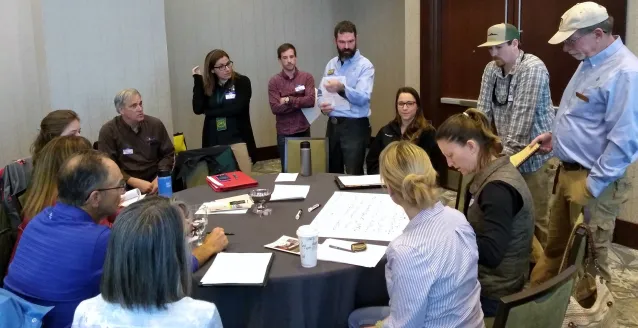
Having thought individually and as groups about what they could stop doing and having gotten back on schedule, the conversation shifted to consider what each group needs from the others (What I Need From You ‘WINFY’ exercise). To make this go more smoothly, exercise sheets were provided for each member and each group to record what their top one or two needs was from the other four groups. Then a spokesperson from each group gathered in chairs, front and center, to make their requests of the four other groups. The teams listened and recorded the requests for group consideration of whether they could fulfill the requested need, try to, or not meet the need. Together again, the groups considered possible solutions that participants have the freedom and resources to do (15% solutions).
These conversations were engaging and fun. It was especially energizing to hear groups reflecting matching needs, such as the fire group requesting more outreach support to accomplish prescribed burning and the resilient landscapes and fire adapted communities groups requesting more prescribed fires or the science group requesting more integration and input on research needs while the other groups were simultaneously providing direct requests for what research they could use. Nearly all of the requests of each other were able to be answered with a “Yes, we can meet your need” during the final report out.
WHAT COMES NEXT?
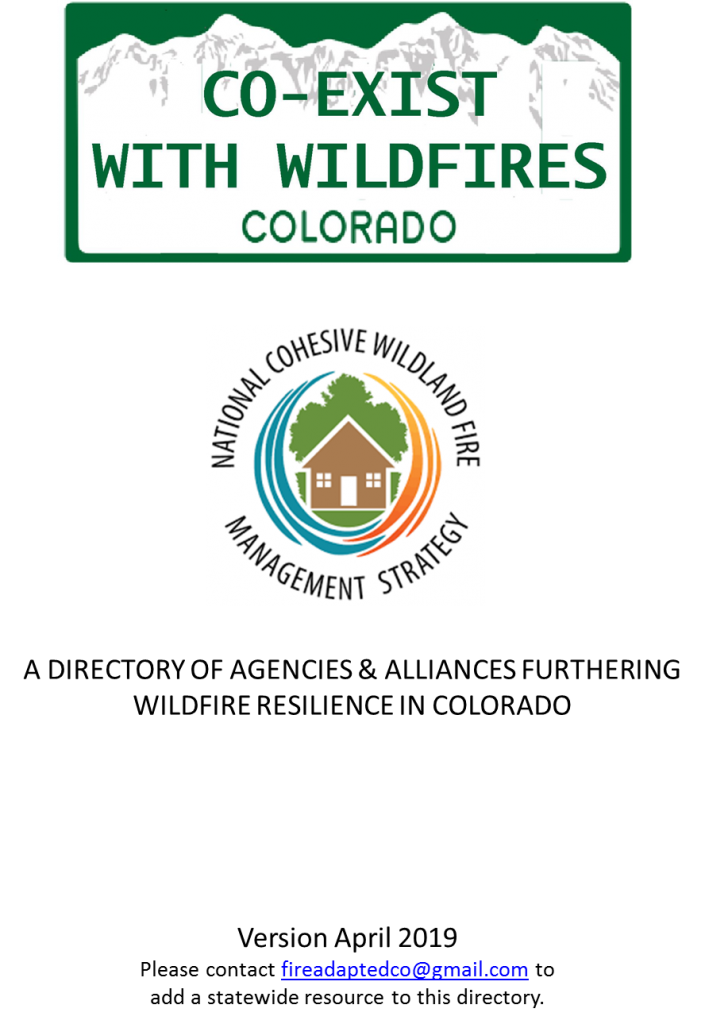 The three-hour gathering concluded with overwhelming support to continue the strategic conversations and action planning that had been launched. I will be following up with the planning team members and sharing a brief post-gathering survey with all participants to solicit their input on how to move the conversation and ideas generated on April 1st forward.
The three-hour gathering concluded with overwhelming support to continue the strategic conversations and action planning that had been launched. I will be following up with the planning team members and sharing a brief post-gathering survey with all participants to solicit their input on how to move the conversation and ideas generated on April 1st forward.
Many participants also requested to receive the template and submit the agency or a group they participate in to a Directory of Colorado Agencies and Alliances Furthering Wildfire Resilience that was initiated through the planning of this event and is in Development. Please watch for more opportunities in the future to voice your ideas and make commitments towards a shared vision for creating better wildfire outcomes in Colorado.
